
YOU ARE HERE!
SPACE







































































































Find out about planets, black holes, asteroids, moons, nebulae … and meet the largest star in the universe
Page 1
LAND, SEA, SKY
Discover volcanoes, lightning, rocks, rivers … and the highest and deepest places on Earth
Page 49
LIVING PLANET
Learn about trees, fungi, fossils, energy … and witness the science of our changing planet
Page 97
This way… look up!
CONTENTS
to Read This Book Page
Introduction Page vi How
x
ANIMALS
Meet creatures that are the fastest, strongest, tiniest, oldest … and discover which are the deadliest
Page 145
Keep going to find out about humans (though personally I find penguins more interesting)
HUMAN BODY
Take a look at muscles, bones, brain cells, poo, wee … and learn how many bathtubs of snot you make in a lifetime
Page 193
HUMAN WORLD
Find out about cars, trains, robots, art, books, war … and uncover the most epic inventions in history
Page 241
Glossary
Page 288
Page 308
Sources Page 296 Index
How far away is the Moon?
As we stand on Earth, the Moon feels relatively close to us, but it is actually hundreds of thousands of kilometres away. If you lined up the seven other planets in our solar system in a row, they would fit in the space between Earth and the Moon. In fact, in a strange coincidence, they would fit rather neatly!
SCALE: 10,000 km
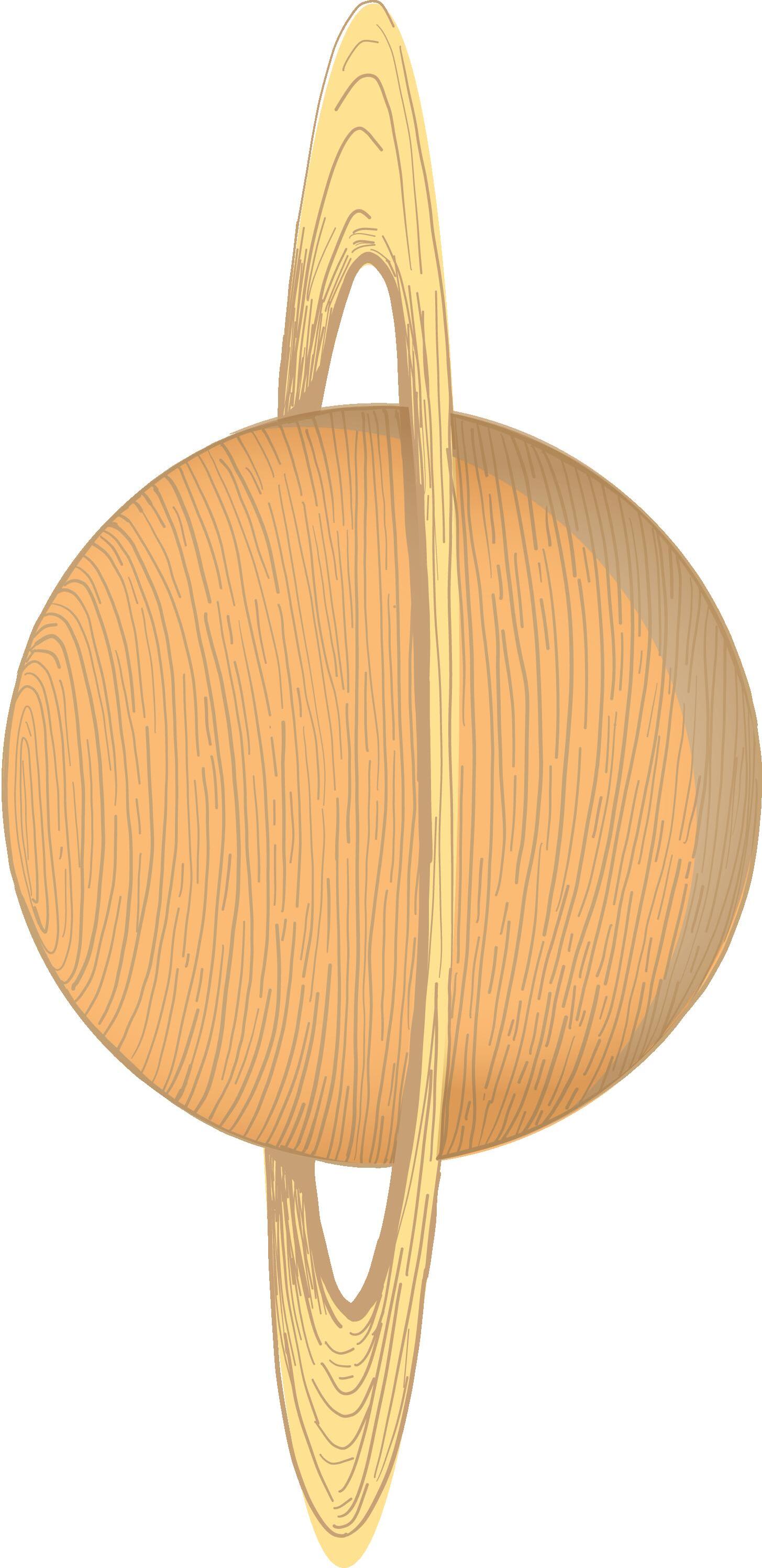
EARTH
EARTH
Alternatively, you could fit 30 planet Earths in the space between Earth and the Moon.
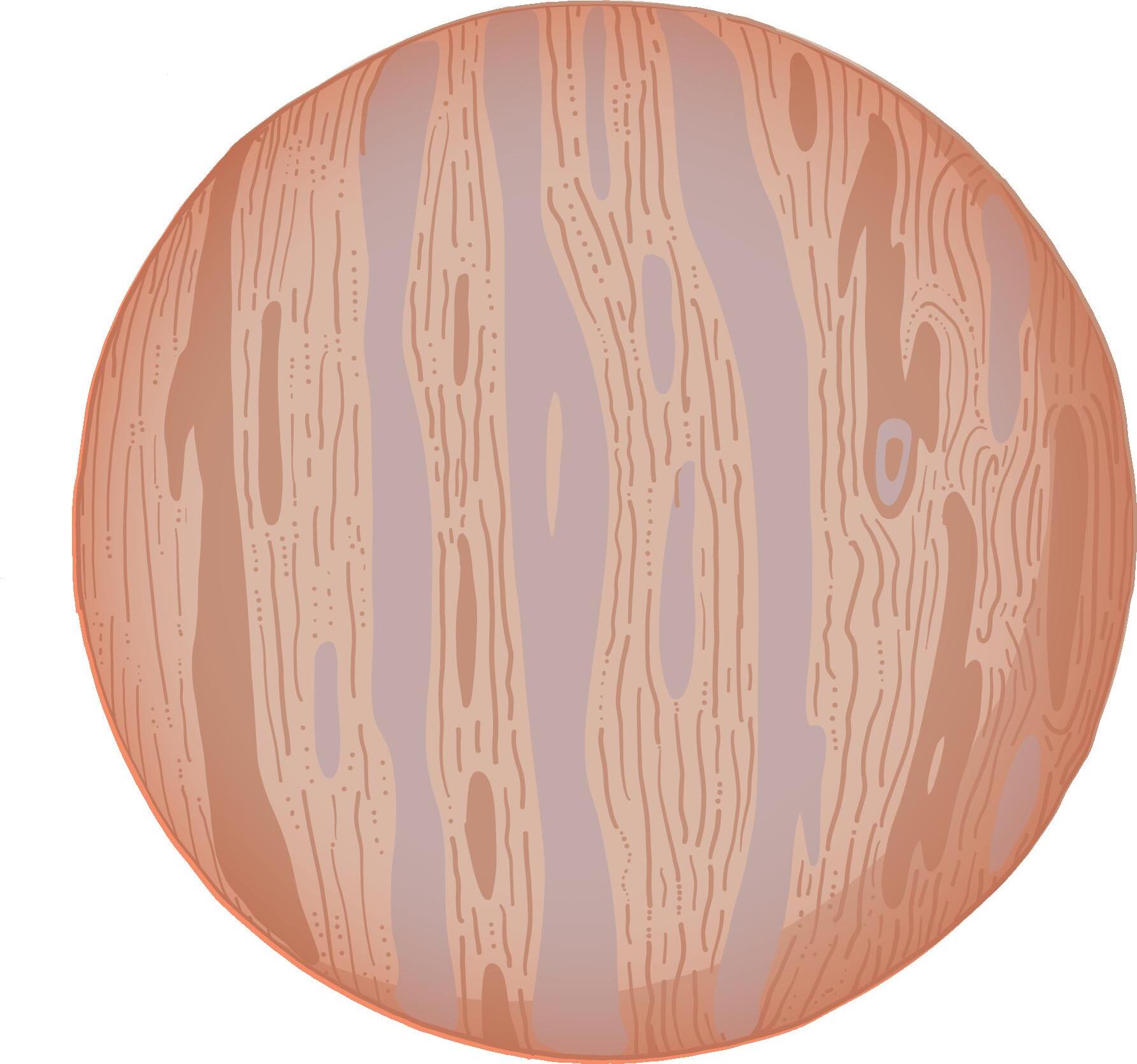
VENUS MERCURY MARS JUPITER
4 Space
THE MOON’S ORBIT

The Moon’s orbit around Earth is not a perfect circle. It’s more like a slightly flattened circle. At its furthest point from Earth, called the apogee, the Moon is 405,500 kilometres away. At its closest point, the perigee, the Moon is 363,000 kilometres away. On average the gap is about 384,000 kilometres. That’s the measurement we’ve used for this infographic.

About 384,000 km
DISTANCE BETWEEN EARTH AND THE MOON
SATURN URANUS NEPTUNE MOON
Perigee Minimum Moon distance Apogee Maximum Moon distance
30x EARTH
MOON Space 5
Wind made visible!
Wind is a swirling mass of air that is created by differences in air pressure. In areas of high pressure, air is heavier, and in areas of low pressure, air is lighter (see page 35). Wind is the flow of air from high- to low-pressure areas. These movements of the wind create the waves and ripples you can see on this map. It shows a snapshot of a very windy day in September 2017 with several hurricanes. As you can see from the map, hurricanes get stronger over oceans and weaker over land.
Winds are stronger over oceans because the air can move more easily over the smooth surface of the water. On land, physical features such as mountains interrupt the flow of wind.
NORTH AMERICA
 Hurricane Otis
Hurricane Norma
Hurricane Otis
Hurricane Norma
32 Land, Sea, Sky
José
NAMING A STORM
Individual storms are named by the World Meteorological Organization, which keeps picking from rotating lists of names. The use of names (rather than numbers, for example) makes the storms easier to remember. It also makes it simpler for the media and weather organisations to put together clear reports about the storms and help the public to prepare for them.
Hurricane Maria. This was one of the most powerful storms of the 21st century to date. It devastated areas of the Caribbean and killed thousands of people.

EUROPE
Sea,
33
Hurricane
Land,
Sky
Leaf spotting
SHAPE
The first thing to identify about a leaf is its overall shape. Here are some of the most common.
CUNEATE
Wedge-shaped, with a narrow base
ACICULAR Needle-shaped
ACUMINATE Ending in a long, thin point
ARISTATE With a spine-like tip
CORDATE Heart-shaped with a stem in the cleft
DELTOID Triangular
DIGITATE With lobes like fingers
ELLIPTIC Oval-shaped, with a small or no point
FALCATE Shaped like a hook or sickle
FLABELLATE Shaped like a fan
HASTATE Triangular with lobes at the base
LANCEOLATE Pointed at both ends
LINEAR Long, with parallel margins
LOBED Deeply indented margins
OBCORDATE Heart-shaped, stem at the point
OBTUSE
With a blunt tip at the end
RENIFORM
Shaped like a kidney
MARGIN
ORBICULAR Round
OVATE Egg-shaped, wider at the base
PALMATE Like a hand with fingers
OBOVATE
Egg-shaped, narrower at the base
RHOMBOID Shaped like a diamond
The edge of the leaf is called the margin. A leaf’s margin can be smooth or wavy or have jagged ‘teeth’.
Find a leaf in a nearby garden or park. What type of margin does it have?
SPATULATE Shaped like a spoon
PEDATE Palmate, but with indented lobes
SPEAR-SHAPED
With a shape and point like a spear
PINNATISECT Deep lobing on opposite sides
SUBULATE Narrowing to a long, thin point
TRUNCATE Flattened off at the tip or base
CILIATE With fine hairs
CRENATE With rounded teeth
DENTATE With symmetrical teeth
DENTICULATE With tiny teeth
DOUBLY SERRATE With different sizes of teeth
ENTIRE Smooth and even
LOBATE With large round indents
SERRATE With large teeth
SERRULATE With small teeth
SINUATE With indentions like waves
SPINY With sharp, stiff points
UNDULATE With curving waves
Just a like a snowflake, the closer you look at a leaf the more there is to notice. Here is a guide to common leaf features and how to spot them.
110 Living Planet
VEIN PATTERNS
Veins inside a plant carry water to and from its leaves in a similar way to how blood vessels carry blood around your body. Plants’ veins also provide the structure and support that give leaves their shape. The arrangement of veins inside a leaf is called venation.
ARCUATE
CROSS-VENULATE DICHOTOMOUS
LONGITUDINAL PALMATE PARALLEL
RETICULATE ROTATE PINNATE
ARRANGEMENT
In some plants and trees, leaves are formed from an arrangement of smaller leaves called leaflets.
PELTATE
With the stem attached to the middle of the leaf
ALTERNATE Leaflets arranged alternately
BIPINNATE Leaflets in pairs of rows
OPPOSITE Leaflets in adjacent pairs
PERFOLIATE With the stem seeming to pierce the leaf
ODD PINNATE Leaflets in rows, with one at the tip
EVEN PINNATE Leaflets in rows, with two at the tip
TRIFOLIATE Leaflets in threes
TRIPINNATE Groups of leaflets in threes
UNIFOLIATE A single leaf
WHORLED
Three or more leaflets arranged in rings
Living Planet 111
How long do animals sleep?
Most animals have a daily pattern of rest and activity. Some animals are more active during the day (diurnal) and some are more active during the night (nocturnal). How much time do animals spend sleeping? Well, it depends on the animal.





Giraffes sleep standing up for ten-minute stints at a time, wth their eyes barely closed. They sometimes lean against a tree or another giraffe for support
HOW TO READ IT













A full day is made of 24 hours, so the two circles in the clock represent 12 hours each. The pink portion indicates the average time each animal sleeps per day.
CHIMPANZEE 9 h, 42 min
BOTTLE-NOSED DOLPHIN 10 h, 24 min
Dolphins keep half of their brain active when they sleep, so that they can continue to breathe. They also only close one eye at a time when they sleep.
GIRAFFE 1 h, 54 min
AFRICAN ELEPHANT 2 h HORSE 2 h, 54 min COW 3 h, 54 min GOAT 5 h, 18 min
20 Animals
12h
24h
HUMAN SLEEP
Humans need different amounts of sleep at different times in their lives. A new baby may sleep for as many as 16 hours a day by taking frequent naps. As children grow into adults, they usually stop taking regular naps and sleep for a single, long period each night.
their favourite is from the
































every day
All that eating and digesting requires a lot of energy, so they spend a vast amount of their time sleeping!
DOG CAT LION 10 h, 36 min 12 h, 6 min 13 h, 30 min SQUIRREL TIGER PYTHON 14 h, 54 min 15 h, 48 min 18 h
BROWN BAT 19 h, 54 min
KOALA 20 h
BABY 16 h
ADULT 8 h
Animals 21
Koalas eat more than a kilo of leaves
–
eucalyptus tree.
How much snot do you make?
Snot may be pretty disgusting, but it’s actually a really important and useful part of your body. It is a type of mucus produced by glands in your nose. Snot traps dust and harmful bacteria and helps you smell things, too. Mucus is also made in your mouth, where it forms part of your saliva. Saliva moistens your food so that it’s easier to eat and swallow. Your stomach produces mucus, too – here, it stops acid from leaking. This is what it would look like if you poured all that gloop together in one place.
LOTS OF MUCUS
Your body produces about five cups of mucus every 24 hours.
Mug capacity 0.3 litres
Most of the snot your nose makes goes down your throat. Gulp.
12 Human Body
A LIFETIME OF MUCUS
Your body produces about 209 bathtubs of mucus in your lifetime.
Your body makes mucus all the time, even while you’re asleep!
180
Human Body 13
Bathtub capacity
litres
More pages from inside the book...

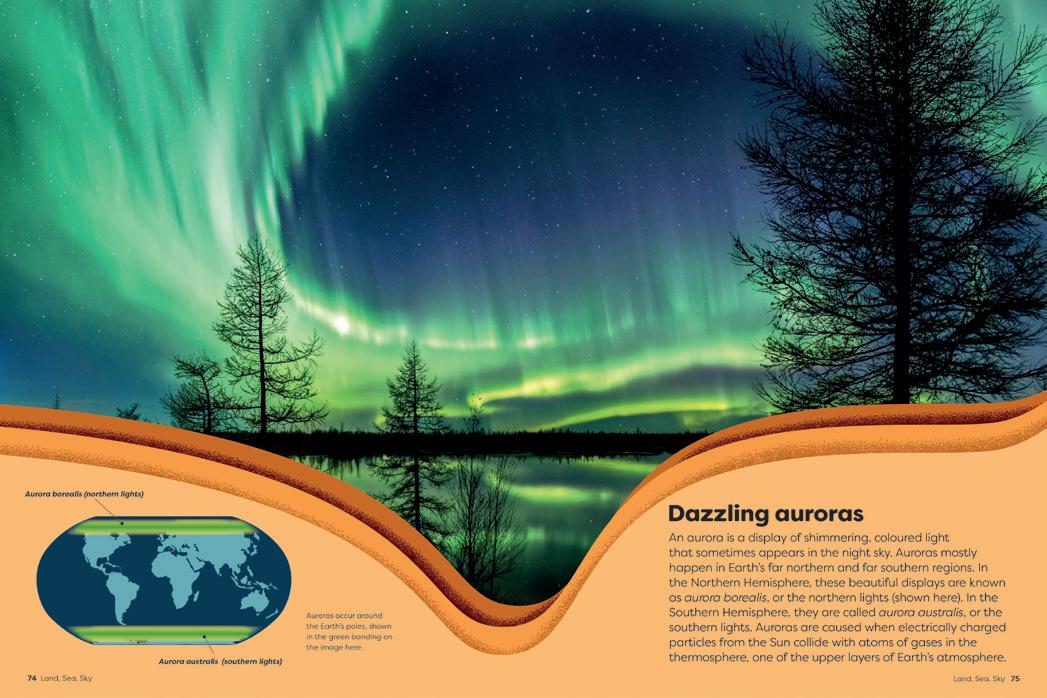

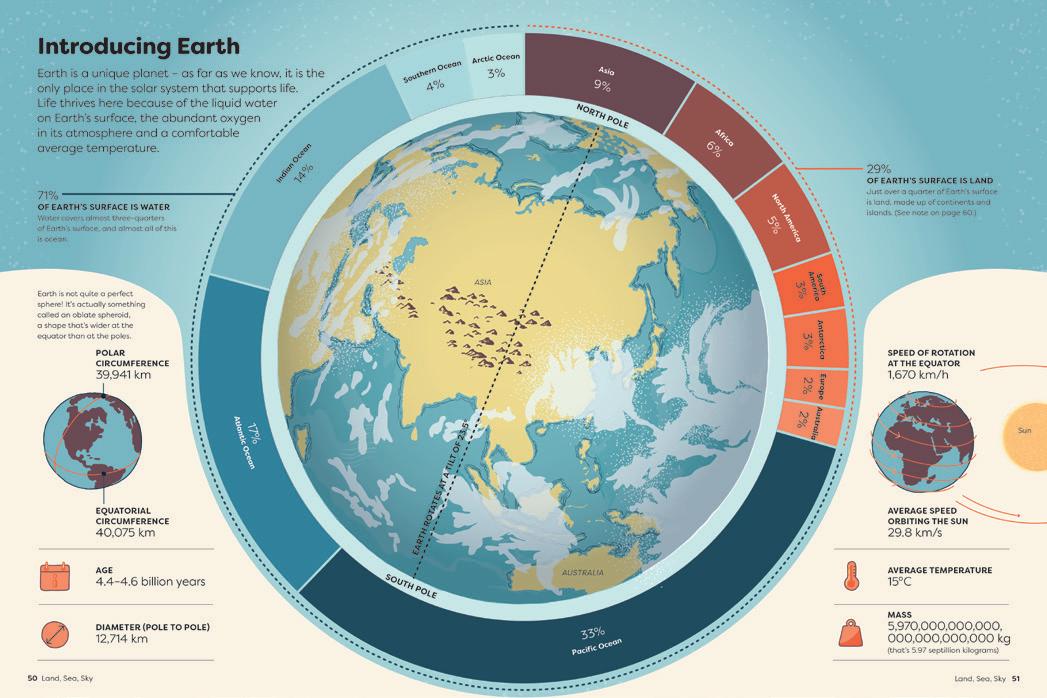

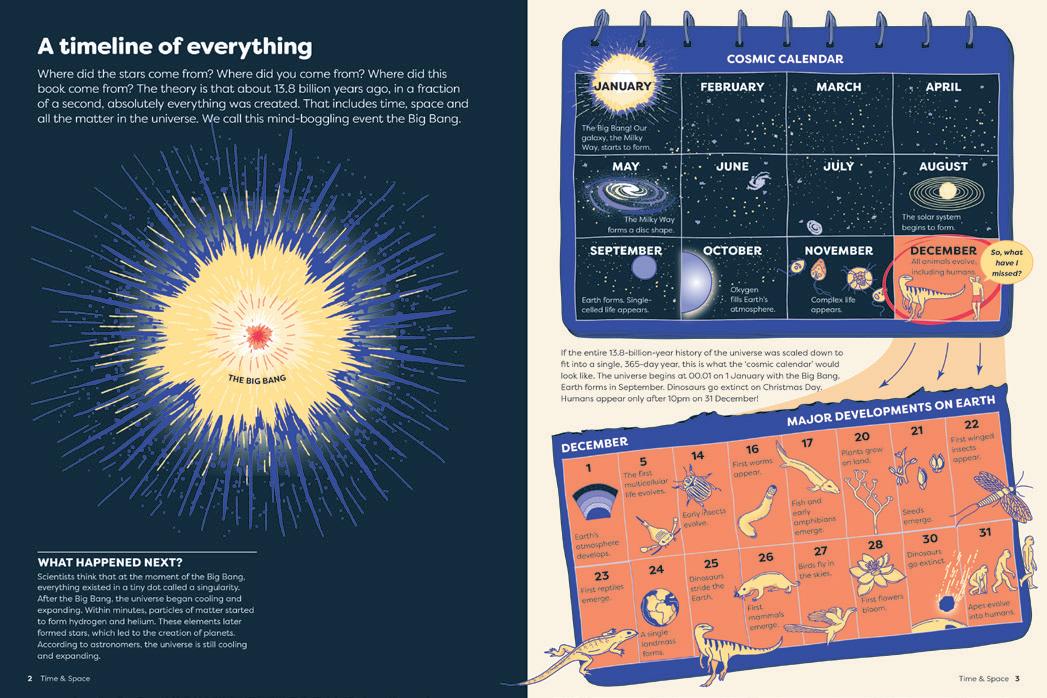

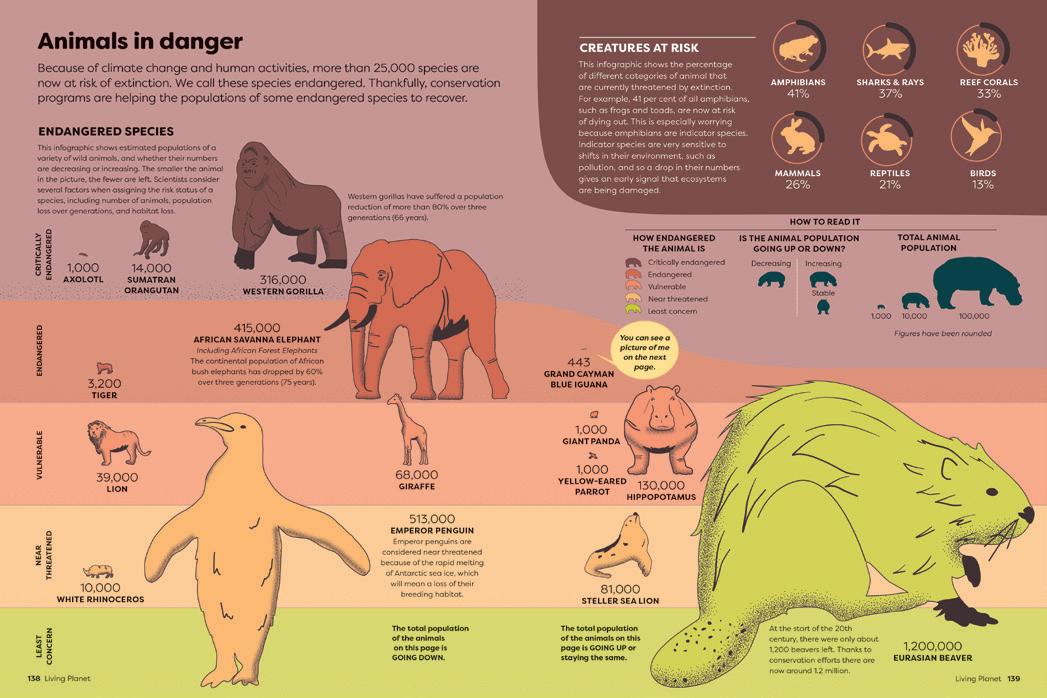




Thousands of facts revealed in pictures
Authors: Andrew Pettie & Conrad Quilty-Harper
Illustrator: Valentina D’Efilippo
Ages: From 10 years
Price: £27.00
Format: Hardback
Extent: 336 pages
Trim size: 280 x 210 mm
Pub date: 21st September 2023
ISBN: 978-1-9137504-5-9
An awe-inspiring encyclopedia with more than 200 original infographic illustrations – the perfect book for visual learners.

This authoritative visual encyclopedia reveals astonishing information about space, Earth, animals, humans and technology through illustrations and graphics (and not too many words!). Grasp facts at a glance as you turn every page: discover the size of our Sun in comparison to the largest star in the universe; find out which animal could leap the human equivalent of three football fields; learn how many cups of snot your body makes a day; compare the sizes of the biggest beasts that have ever lived; witness what happens in a single second across the world. With stunning infographics by internationally renowned data visualiser Valentina D’Efilippo, along with beautiful colour photography, as well as interviews with expert consultants for every chapter, this ravishing book from Britannica offers a groundbreaking visual way to understand and marvel at the world around us.
Selling points
•Includes more than 200 specially commissioned infographics, as well as stunning colour photography.
•Uses illustrations to reveal information – you’ll discover astonishing facts at a single glance.


•The ultimate STEAM book, in which science, maths and art meet to reveal powerful true stories about our amazing world.

•Every page is underpinned by data and facts researched by specialist data researchers and verified by Encyclopaedia Britannica.
• Features leading expert consultants for each chapter.
Authors
Andrew Pettie is a writer, editor and journalist who has contributed to The Times, Sunday Times and the Daily Telegraph, where he was Head of Culture. Andrew is the author of Listified! (published by Britannica Books) and the editor of Britannica Magazine.
Conrad Quilty-Harper is a journalist at Bloomberg News in London. He previously worked at New Scientist, British GQ, the Daily Mirror and the Daily Telegraph, often using data and infographics to tell stories. He plays the trombone, likes aeroplanes, and his favourite type of graph is the sankey diagram.
Illustrator
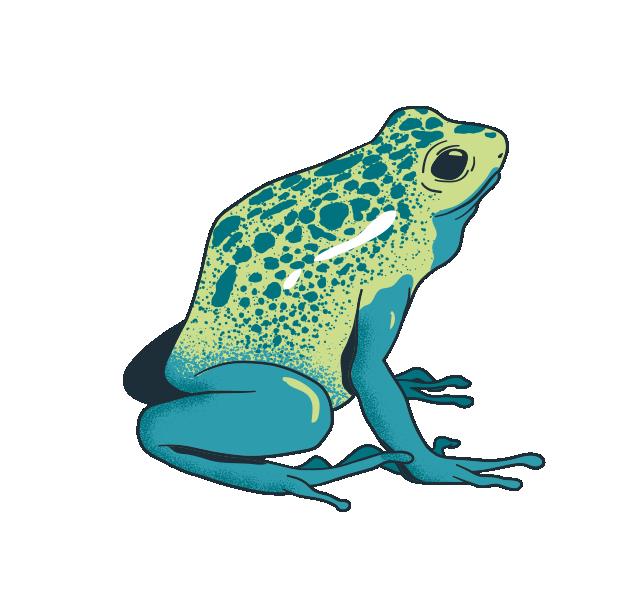

Valentina D’Efilippo is an award-winning data visualiser and illustrator. She is the co-creator of The Infographic History of the World (Firefly, 2013) which has been sold in 9 languages, she presented a TedX talk on Data Design in 2021, and she leads workshops for students and professionals, including masterclasses with the Guardian about visual storytelling with data. This is her first children’s book.
BOUNCE SALES & MARKETING – 320 City Road, London EC1V 2NZ | Tel: 020 7138 3650 | Fax: 020 7138 3658 | sales@bouncemarketing.co.uk
ORDERS – Grantham Book Services, Trent Road, Grantham, Lincolnshire NG31 7XQ Tel: 01476 541000 | Fax: 01476 541060 | orders@gbs.tbs-ltd.co.uk
WHAT ON EARTH PUBLISHING – The Black Barn, Wickhurst Farm, Leigh, Tonbridge, Kent, TN11 8PS | Tel: 01732 464621 | info@whatonearthbooks.com | whatonearthbooks.com
9 781913750459
Britannica’s
































































 Hurricane Otis
Hurricane Norma
Hurricane Otis
Hurricane Norma


























































